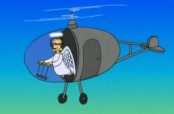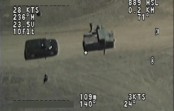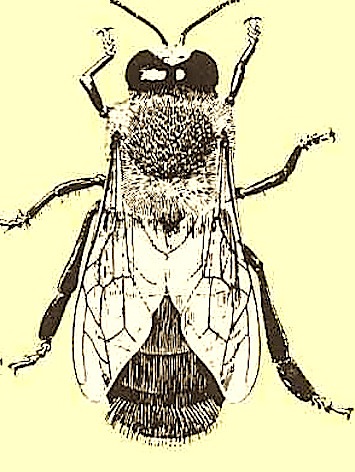BIRDS AND BEES
Before they were raining down from a great height‡
 ‡Off with his head, man.
‡Off with his head, man.Characteristically, neither device pleased Archytus' close friend Plato, who grumbled that God was the only true geometer.
Aristotle did record a reaction to Archytas' inventions, fitting for someone whose famed dictum‡
The bird was apparently suspended from the end of a pivoted bar, and the whole apparatus revolved by means of a jet of steam or compressed air.
Archytus had cleverly engineered a second mechanical device, this one
to give to children to occupy them, and so prevent them from breaking things about the house (for the young are incapable of keeping still).
A cartoonishly fluffy Poof! carries this aeronautics history 2,330 years forward to 1980, when in his roomy Hacienda Heights garage Abraham Karem, an engineer employed in the cadre of the Israeli Air Force for nine years, invented The Albatross aircraft. The Albatross is the forerunner to The Predator, which launched Hellfire missiles that killed Anwar al-Awlaki and three others on 30 September 2011, and his son Abdulrahman al-Awlaki and nine others almost exactly a month later.
Why emphasize the personae behind the earliest B.C.E. form of a gadget that would experience a profound transformation beyond the twentieth century? On the contrary, any successful engineer disappears beneath the exterior of his or her creation (thinking of Heidegger's notion of tools disappearing in users' hands to the transparent objects in The Matrix trilogy). And the creator's intention has never been a strong suite; even modern drone-maker Karem admitted that he 'did not envision the collapse of the Soviet Union and the rise of warfare with non-state adversaries.' At a surveillance conference I spoke with a drone researcher who had watched engineers test their devices in air fields. The contention that their scientific research would be used in stealth warfare to kill combatants or noncombatants visibly horrified them (convincingly or not—but the separation barrier between inventor/invention and user/tool, at least how it is grasped socially, appears dense).
More than any other military extermination device, how come drones are the most persuasively anthropomimetic?
 An AeroVironment promotional video in which a small military drone films its handlers. Source: ibid.
An AeroVironment promotional video in which a small military drone films its handlers. Source: ibid.EVEN A PARANOID CAN HAVE ENEMIES
How do we deliver justice to the enemy? I think there are different ways. It can be delivered through trials. Drones also delivers.—Harold Koh
The first imperative of paranoia is There must be no bad surprises. —Eve Sedgwick
At the suggestion of several people I recently read Eve Kosofsky Sedgwick's essay, 'Paranoid Reading and Reparative Reading, or, You're So Paranoid, You Probably Think This Essay is About You.'
Yet something remarkable happened, and this is the historical crux on which Sedgwick's project (as she adapts to the historical nature of unveiling as a socio-political exercise) lies:
It used to be opponents of capital punishment who argued that, if practiced at all, executions should be done in public so as to shame state and spectators by airing of previously hidden judicial violence. Today it is no longer opponents but death penalty cheerleaders, flushed with triumphal ambitions, who consider that the proper place for executions is on television. What price now the cultural critics' hard-won skill at making visible, behind permissive appearances, the hidden traces of oppression and persecution? (141)
But one must push this epiphany about visible carceral punishment further (and I am not faulting for Sedgwick for failing to do so, since at the time of the book's publication the U.S. was only two years into the global War on Terror, and the government's current legal defense, made up of people like Harold Koh, were then blasting George W. Bush as a 'torturer in chief' who used sadism to extract confessions from suspects rather than obliterate them on the spot). The drone can be offered a peculiar and rare place in Sedgwick's formulation about visible and hidden punishment.
Does it matter when state murder is off-scene? For example, in both Al-Awlaki & Co. killings, one assumes the targets simply evaporated into the air. The non-visibility of the deaths certainly matter, but what does it do? Sedgwick is obsessed with the doings or performances of these social dramas, and I am asking these things because I am not fully sure. It is important that 'we the international public' know that the killing of suspects has taken place, but that those killings are contingent on state secrecy, sovereignty, and off-scenity is what makes them even more peculiar. Gone is the rich and highly disturbing imagery of detainees under Bush II. The circulated picture of detainees at Camp X-Ray, for example, was a Department of Defense photo-op (Sedgwick: 'behind permissive appearances') that served important social functions: let this deter you from thinking the U.S. will sit by idly as terrorists run amok, these men are about to be given a medical exam to assess their health, this is how to tame monsters, etc. However reprehensible the earlier years of the global 'War on Terror,' these pictures appeared intentionally or via leaks, and frequently, especially in the years following the live execution of Saddam Hussein.
This visualization has virtually ended since at least the off-scene killing of Osama bin Laden.
This sensibility conjures the idea that we are in some kind of post-cinematic age where the maximum attentive ability that can be expected from a sentient public is to stay watching (in the multiplex of Twitter?) as attuned, informed spectators. There is an entire cottage industry of Bush-era movie-making. If a Michael Bay or a Spielberg were to concoct the spectacle of a drone movie, what would it even show? Certainly not the teenager Abdulrahman playing sports with his friends seconds before the drone blast. If charitable, it would film the point-of-view of a drone operator sitting in an air-conditioned unit in Nevada. The drone may be empty of a human being but neither foreign onslaughts nor North American cinema are ever short of machine subjectivity. That's what brings up paranoia.
Paranoia informs a critical queer position or practice for Sedgwick since it spread from being a 'privileged object of antihomophobic theory' to a methodology (126). Sedgwick says that the paranoia transposed on the homosexual, especially prior to the 1980s, illuminates 'not how homosexuality works, but how homophobia and heterosexism work—in short, if one understands these oppressions to be systemic, how the world works' (ibid).
Paraphrasing Barthes on the intelligence required to be a functioning paranoid, Sedgwick comments,
Paranoia requires that bad news be always already known. (130)
There must be no bad surprises.
I juxtapose this finding with an excerpt from Silvan Tomkins' Affect Imagery Consciousness, substituting the selective scanning of a drone for the cognitive apparatus of the human brain:
Like any highly organized effort at detection, as little as possible is left to chance. The radar antennae are placed wherever it seems possible the enemy may attack. Intelligence officers may monitor even unlikely conversations if there is an outside chance something relevant may be detected or if there is a chance that two independent bits of information taken together may give indication of the enemy's intentions... But above all there is a highly organized way of interpreting information so that what is possibly relevant can be quickly abstracted and magnified, and the rest discarded.
For Sedgwick (via Tomkins), paranoia is not only a strong affect theory (strong here meaning wide-ranging and reductive) but a 'strong negative affect theory.' On the affective range, a strong negative affect would be organized around preempting and forestalling the negative affect of humiliation. In the traditional zone of combat—my go-to stock imagery for this is the trench warfare of World War I nearly every American child is exposed to in school—a paranoid soldier behaves vigilantly to prevent any bad surprises. Even in the era of 'smart bombs' and aerial combat a pilot or commander embodies the role of a highly attuned paranoiac. Why wouldn't drones?
NEVER SEND A HUMAN TO DO A ROBOT'S JOB
Very frankly, [drones are] the only game in town. —Leon Panetta
Some have argued that the president is required to get permission from a federal court before taking action against a United States citizen who is a senior operational leader of Al Qaeda or associated forces. This is simply not accurate. ‘Due process’ and ‘judicial process’ are not one and the same, particularly when it comes to national security. —Eric Holder
To absolve itself in the most sensitive strikes, the CIA has become skilled at using lawyers to cover its tracks. "They use paper when it is going to help them," says the former [CIA] official. —Michael Hastings
They killed my son Anwar without a trial for any crime he committed. —Nasser Al-Awlaki
What's different about extrajudicial killing by drone than other supposedly conventional attacks? Would Nasser Al-Awlaki mourn the killing of his 16-year old grandson Abdulrahman and son Anwar any differently than if they were killed using routine tactics and aircrafts? Inseparable from the position of state sovereignty and secrecy, probably not. But as he told Michael Hastings, the ceaseless drones buzzing in southern Yemen have a direct physical manifestation in the lives of people there. They have made life a living hell: 'They make unbelievable noise, and people are suffering.'
If the term 'bureaucracies of violence,' alternatively used to describe the state, is not unsettling enough, one might consider Nasser al-Awlaki v. Barack Obama, where in a highly unusual outcome the case was dismissed because Nasser's son, who was on a targeted killing list, had not actually been murdered yet.
The transcript from the hearing reads like a Kafkaesque parody of a trial. The government's lawyer, Douglas Letter, repeatedly invoked the privilege of state secrecy, arguing that 'as far as the allegations there is a kill list, et cetera, we're not confirming or denying.'
The veil that envelopes military drone action into ever more shrouds of official secrecy is, one: their being off-scene, two: reappearing in multiple territories of combat at once, and three: their extreme paranoia.
In Laura Mulvey's volume Death 24x a Second it is argued that a viewer in the contemporary age can delay or slow down time cinematic time by taking still images of a medium that is constituted by time. Whether or not one agrees with Mulvey (Maria Walsh doesn't), the argument that authorship, authenticity, and totality within the work (to the extent that they survive the electronic era) are downplayed is fairly persuasive. By extension, that's what makes the drone's motto, Death by Remote Control, so stinging. Total war gets replaced by scenes in fragment. Who gets 'authorship' for the kill, the operator behind a computer screen in Nevada? Authenticity exists only as far as a targeted killing can be identified: U.S. soldiers cannot avail themselves of the opportunity to defile or pose with dead body parts or corpses because those remainders vanish into smithereens.
One recent attempt at reconstituting the authorship, authenticity, and (near-) totality of statecraft emerged in the form of the meme Texts from Hillary. Later a détournement called Texts from a Drone appeared, turning the efforts of the first on its head. What should astonish us (I choose to be astonished by this) is that a drone is so easily endowed with a subjectivity. Following this, that drone subjectivity is not at odds with Hillary's swift, no-nonsense, machine-like delivery (a quality for which she's handsomely rewarded with fan adulation and fawning). If Hillary is utterly convincing as a robot-heart with a human appearance (her pressing concern at the moment, if such accounts are to be believed, is her legacy on the status of women in Afghanistan, their lives perpetually serving to mirror back on the reflective surface of others' achievements) then so is the android with its smiley-faced, acronym-filled expressions and puns ('How was Coachella?' 'It was a blast!!1!').
Would the cutting or biting (if simplified‡) satire of the meme work if it centered on an F-16 jetfighter or any other military-jocked aircraft? Safely assume not, because the perspective of the human inside the cockpit of those planes would adulterate the experience of a personified, powerful (and paranoid) robot. Pure perspective would get lost. There's no Drunk Predator Jet, but there is a Drunk Predator Drone, whose tweets stream in with the mosquito sounds of an optimistic, indolent summer in the South.
A drone may trace its roots to the idle or lazy male honeybee, but it is never stupid. This culture doesn't typically associate lazy or drunk workers with intelligence, if the singular place of Homer Simpson in the iconography of popular culture is any indication. But you have to be particularly attentive and conscious and intelligent (and sufficiently paranoid about your own survival) to maneuver the delay of the hours and the movements of people to be either lazy or idle or drunk on the job, which both kinds of drones engender.
